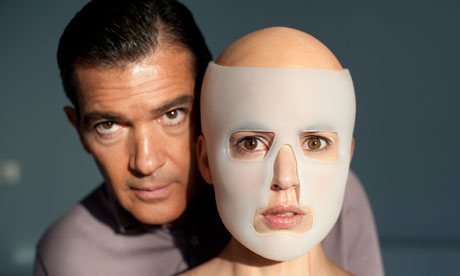
Shortly to celebrate his 62nd birthday, Pedro Almodóvar is at his daring, provocative and allusive best with the scintillating The Skin I Live In (La piel que habito). A combination of dark thriller, gothic horror story and poetic myth, it visits most of the preoccupations of his work over the past 30-odd years from maternal devotion through sexual identity to obsessional activity.
It's based on a 120-page French novel, Mygale, by the late Thierry Jonquet (published in Britain as Tarantula), in which an eminent French plastic surgeon has a practice at a public hospital in Paris, a private clinic in Boulogne, a secret operating theatre in the basement of his suburban mansion, a beautiful, submissive partner called Eve whom he keeps under lock and key, and a teenage daughter in an asylum.
Jonquet's novella has been described by an American critic as resembling "an unholy collaboration between Sade and Sartre" and is clearly much influenced by Georges Franju's horror film Eyes Without a Face, a surreal classic in which Pierre Brasseur played Dr Génessier, a plastic surgeon obsessed with grafting the faces of abducted Parisian girls on to his daughter, disfigured in a car crash.
Almodóvar has tempered Jonquet's extremely cruel tale, shifted the relationships around and relocated the narrative to Toledo, the beautiful city south of Madrid where his idol, Luis Buñuel, set his 1970 masterpiece Tristana, a psychological drama of controlled savagery about the destructive affair between an elderly, liberal aristocrat (Fernando Rey) and his beautiful ward (Catherine Deneuve).
In The Skin I Live In, the plastic surgeon has become Robert Ledgard (a commanding performance of icy control by Antonio Banderas, working with Almodóvar for the first time since 1990's Tie Me Up! Tie Me Down!), living a stylish life with a devoted housekeeper to look after his beautiful mysterious prisoner, whose name has been changed from Eve to the more ambiguous Vera. The housekeeper, played by the formidable Marisa Paredes, proclaims: "I've got insanity in my entrails", and a crazy son turns up in flight from the police, demanding that Robert provide him a new face.
Robert's principal public project, inspired by his late wife's destruction in the blazing fury of a motor accident, is the development of a new form of skin that will be sensitive to the touch but resistant to fire. Naturally his medical colleagues are both jealous of his achievement and troubled that in a ruthless search for success his research is taking him into ethically impermissible areas.
But he's also involved in secret activities of a more dangerous nature. They're to do with revenge at a personal level and, on a cosmic plane, with challenging the very character of human identity. Inevitably reducing his stature in our minds, the audience recognises him as that celebrated movie figure, the mad scientist, whose most famous antecedent is Dr Frankenstein, and most infamous current avatar the loony doctor in the Dutch horror flick The Human Centipede. Of these particular plot details I will say no more, because they involve twists and revelations of a surprising and shocking kind.
Robert is a hubristic scientist, a man questioning the nature of what we have traditionally been taught to regard as natural. He is also that part of all of us that in one way or another attempts to reshape the world according to our own devices and desires rather than accepting things as they are. In this way he resembles Scottie Ferguson, the detective played by James Stewart in Hitchcock's Vertigo, one of Almodóvar's favourite films, who transforms a woman he meets by apparent accident into the ideal image of one he has lost and feels guilty over.
There are echoes here of God conspiring with Adam to create another being as in the second chapter of the book of Genesis, and there are two peculiarly poignant scenes where at different times and in different places, a pair of related characters appear – in a seemingly natural way and with great tenderness – to be creating new beings. In one case a man makes scarecrow-like women with twigs and straw to take their place in the window of a chic boutique as mannequins wearing vintage dresses; in the other a woman makes copies of doll-like creatures from wool and cotton, modelled on Louise Bourgeois sculptures.
The Skin I Live In is a skilful piece of storytelling that reorganises time and, in a characteristic Almodóvar fashion, challenges our preconceptions about everyday life and personal conduct. The title takes its central character's profession and turns it into a metaphor for our bodies, our identities, our perceptions of ourselves. Skin is what contains us and appears to define us and, indeed, a crucial scene sees Robert's wife mortified by looking at what has happened to her face. But would a transformation of our appearance or, more radically, the reorganisation of our bodies make us other than we know ourselves to be? As in all the films of his maturity from the mid-1990s onwards, Almodóvar, while often appearing camp and frivolous, memorably explores profound emotional and intellectual matters. He does in this cool, elegant and moving film, beautifully lit as usual by cinematographer José Luis Alcaine.

